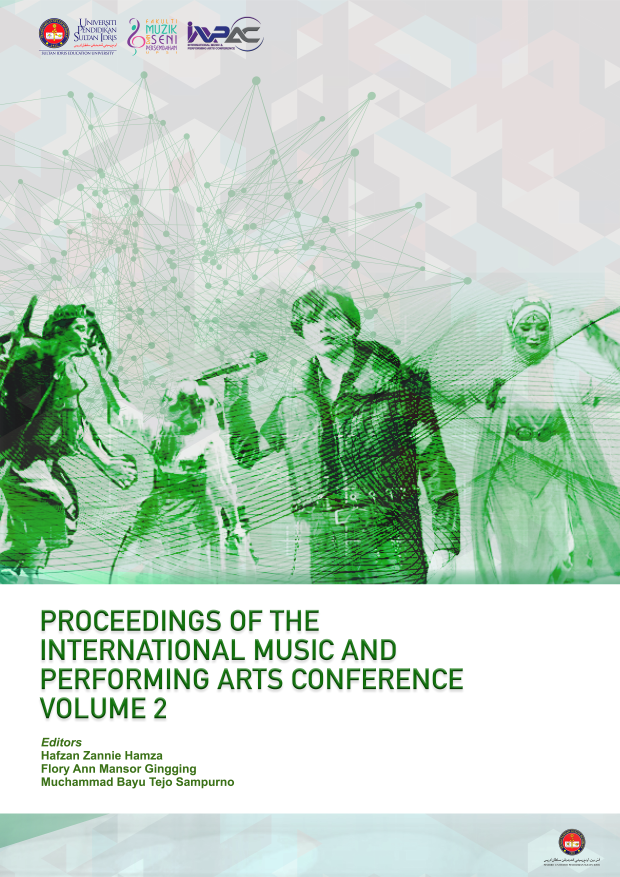Ngringkes: Garap's Adaptation on Jemblungan Music
DOI:
https://doi.org/10.37134/impac.v2.8.2024Keywords:
adaptation, change, jemblungan, musical performance, ngringkesAbstract
This paper delves into the adaptation and transformation of Jemblungan music within the traditional cultural of the Selo community, located in Boyolali Regency, Indonesia. Traditionally, Jemblungan was performed by 30-35 musicians and served as a medium for religious expression, facilitating communal harmony and spiritual communication. Over time, however, Jemblungan's role has shifted due to various factors, such as advances in technology, changes in information dissemination, and the growing influence of tourism in the region. These changes have led Jemblungan to evolve from its religious origins into a form of entertainment that caters to a broader audience, including visitors and tourists. A key element in this adaptation is the concept of Ngringkes, a community-led effort to streamline Jemblungan performances in response to modern needs. The process of Ngringkes reduces the number of performers from 30-35 to 12-15 and shortens the duration of performances, making the art form more suitable for modern, fast-paced settings. This adjustment has allowed Jemblungan to remain relevant, balancing its traditional cultural roots with the entertainment demands of contemporary audiences, particularly in tourist hotspots. The study analyzes how Ngringkes functions as an adaptive strategy, focusing on both internal factors (such as community attitudes and traditional practices) and external factors (like audience preferences, market demands, and tourism pressures). Furthermore, it explores how these adaptations impact the symbolic meaning and cultural value of Jemblungan within the community, considering how its transformation reflects broader societal changes. By examining the role of Ngringkes, this research provides insight into the ways in which cultural traditions can evolve while maintaining their essential identity, ensuring that Jemblungan continues to thrive as both an art form and a living tradition.
Downloads
References
Adumati, A. O. (2023). A study of Linda Hutcheon’s theory of adaptation in ‘Ààre Ajagungbadé’: An adaptation of William Shakespeare’s Macbeth. Creative Artists: A Journal of Theatre and Media Studies, 17(2), 226.
Agus Mega Saputra, G., Suryadmaja, G., & Puspita Ningsih, D. (2024). The impact of changes in scale configuration on the gangsa instrument of the Bhavana Ethnic Mataram as an Indonesian music innovation. Dewa Ruci: Jurnal Pengkajian Dan Penciptaan Seni, 19(1), 20–28. https://doi.org/10.33153/dewaruci.v19i1.5887
Bisri, M. H. (2007). Perkembangan tari ritual menuju tari pseudoritual di Surakarta. Harmonia Jurnal Pengetahuan Dan Pemikiran Seni, VIII(1), 8. https://journal.unnes.ac.id/nju/harmonia/article/view/798
Efendi Junarto, K. E. (2012). Barongan Jogo Rogo dalam tradisi selapan dino. JOGED Jurnal Seni Tari, 3(1), 3. http://journal.isi.ac.id/index.php/joged/article/download/2/2
Hutcheon, L. (2013). A theory of adaptation (2nd ed.). Routledge.
Jantro, G. S. B., & Kiswanto, K. (2023). Adaptasi dan perkembangan kesenian ebeg Banyumasan pada komunitas diaspora Jawa di Sumatera Selatan. Jurnal Kajian Seni, 10(01), 31–44.
Mack, N., Woodsong, C., Macqueen, K. M., Guest, G., & Namey, E. (2005). Qualitative research methods: A data collector’s field guide.
Makmur Jaya, & Rita Zahara. (2022). Hiburan media (Teori-teori universal hiburan media, hiburan sebagai mesin emosi, hiburan sebagai komunikasi, teori hiburan interaksi). Jurnal Ilmiah Teknik Informatika Dan Komunikasi, 2(1), 73–74. https://doi.org/10.55606/juitik.v2i1.237
Puspitasari, P. (2016). Penelitian terhadap struktur cerita, konteks, ko-teks, proses pewarisan, fungsi, nilai-nilai, dan ancangan model revitalisasi tradisi lisan jemblung Jawa Timur. Jurnal Penelitian Pendidikan, 15(1). https://doi.org/10.17509/jpp.v15i1.1287
Raharjo, I. (2018). Fungsi dan bentuk pertunjukan kesenian jemblung sebagai hasil komodifikasi budaya Panji Asmarabangun di Kediri. Prosiding Seminar Antar Bangsa-Seni, Budaya, Dan Desain, 54–63.
Rahmadhani, F., Asril, A., & Halim, M. (2023). Ratok Si Bunsu: Interpretasi ilau ke komposisi pendekatan tradisi. Gorga: Jurnal Seni Rupa, 12(2), 421. https://doi.org/10.24114/gr.v12i2.49076
Ruastiti, N. M., Sudirga, I. K., & Yudarta, I. G. (2021). Wayang Wong Bali performance in era pandemic Covid-19. IOP Conference Series: Earth and Environmental Science, 724(1), 1–7. https://doi.org/10.1088/1755-1315/724/1/012109
Simanjuntak, D., & Fitriana, R. (2020). Culture shock, adaptation, and self-concept of tourism human resources in welcoming the new normal era. Society, 8(2), 431. https://doi.org/10.33019/society.v8i2.200
Sugiyono. (2010). Metode penelitian kuantitatif kualitatif dan R&D. Alfabeta.
Sunaryo, T. B. (2021). Seni pertunjukan ritual sebagai bahan refleksi kepariwisataan dalam menghadapi dampak Covid-19. Kepariwisataan, 1, 184–185.
Suryadmaja, G. (2013). Dampak implementasi ICT dalam pembelajaran. Jantra, Jurnal Sejarah Dan Budaya, 8(1), 29–38.
Suryadmaja, G. (2014). Ngringkês: Adaptasi garap pertunjukan hiburan jemblungan Desa Samiran Kecamatan Selo Kabupaten Boyolali [Master’s thesis, Universitas Gadjah Mada Yogyakarta]. https://etd.repository.ugm.ac.id/penelitian/detail/68894
Veronica, S. A., Irdawati, I., & Maizarti, M. (2021). Turuk Lajo Simagere dari tarian ritual ke seni pertunjukkan di Kepulauan Mentawai. Laga-Laga: Jurnal Seni Pertunjukan, 7(1), 13. https://doi.org/10.26887/lg.v7i1.1530
Wardhana, I. H., Permana, C. E., Puspitasari, M., & Chotib, C. (2022). Adaptation of Betawi traditional music performers to preserve their existence in a new normal era. Humaniora, 13(3), 226. https://doi.org/10.21512/humaniora.v13i3.7966
Yunus, H. A., Ks, S. D., Mintosih, S., Soeloso, & Soimun. (1994). Kesenian dalang jemblung sebagai sarana penyebaran nilai budaya. Departemen Pendidikan dan Kebudayaan Direktorat Jenderal Kebudayaan Direktorat Sejarah dan Nilai Tradisional Proyek Pengkajian dan Pembinaan Nilai-Nilai Budaya Pusat.
Downloads
Published
Issue
Section
License
Copyright (c) 2024 Galih Suryadmaja, Dewi Puspita Ningsih (Author)

This work is licensed under a Creative Commons Attribution-NonCommercial-NoDerivatives 4.0 International License.
Authors retain copyright and grant the Proceedings of the International Music and Performing Arts Conference (IMPAC Proceedings) the right of first publication.
This licence permits unrestricted use, distribution, and reproduction in any medium, provided the original work is properly cited.




